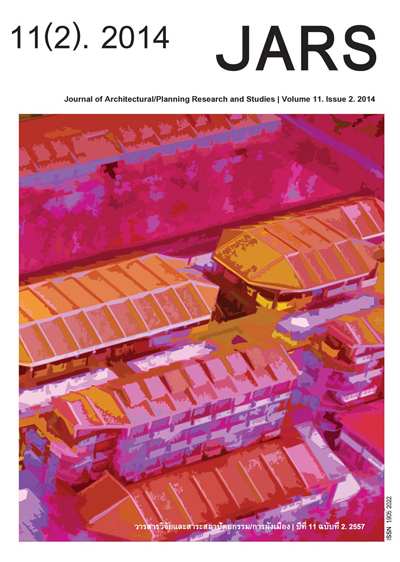Potential of Energy Saving from Daylight Usage under Ministerial Regulation
Main Article Content
Abstract
To enhance the use of daylight, lighting power density (LPD) load in building can be deducted by designing for energy conservation according to ministerial regulation’s conditions. However, the methods and benefits are not clearly defined. These problems also affect architectural design framework. This is an experimental research aims to explore the potential of daylighting by using DIALux software to simulate daylight level in office building. The results indicate that 1) within the room depth of 1.5 times window head height; most of the results from 4 types of studied windows cannot provide adequate illuminance (300 lux) on workplane. Artificial lights are still needed to be turned on to maintain minimum illuminance level. Therefore, the energy saving purpose is unachieved. 2) The orientation of windows affects on both illuminance and distance of useful daylight. 3) With proper design integration, it is possible to reduce glazing area. 4) Skylight is an effective mean to introduce and distribute daylight into building. 5) For visual comfort issue, daylight quality should be concerned. Finally, the results of this research will propose guidelines for developing design criteria and evaluation method in the future. This will reflect the actual energy consumption and saving.
Downloads
Article Details

This work is licensed under a Creative Commons Attribution-NonCommercial-NoDerivatives 4.0 International License.
All material is licensed under the terms of the Creative Commons Attribution 4.0 International (CC-BY-NC-ND 4.0) License, unless otherwise stated. As such, authors are free to share, copy, and redistribute the material in any medium or format. The authors must give appropriate credit, provide a link to the license, and indicate if changes were made. The authors may do so in any reasonable manner, but not in any way that suggests the licensor endorses you or your use. The authors may not use the material for commercial purposes. If the authors remix, transform, or build upon the material, they may not distribute the modified material, unless permission is obtained from JARS. Final, accepted versions of the paper may be posted on third party repositories, provided appropriate acknowledgement to the original source is clearly noted.
References
ASHRAE. (2010). ANSI/ASHRAE/IES Standard 90.1-2010: Energy standard for buildings except low-rise residential buildings (I-P edition). Atlanta: ASHRAE.
Chindapol, S., Sreshthaputra, A., Tisavipat, P. & Srisutapan, A. (2008). แนวทางการออกแบบช่องเปิดเพื่อได้รับความร้อน และแสงธรรมชาติอย่างเหมาะสมในอาคารสำนักงาน [Fenestration design guidelines for optimizing heat gain and daylight in office building]. Conference on Energy Technology Network of Thailand: E-NETT, 4, 299-305.
Chou, S. K. & Chan, W. L. (1996). A generalized methodology for determining the total heat gain through building envelopes. International Journal of Energy and Research, 20(10), 887-901.
Cofaigh E.O., Fitzgerald E., Alcock R., Lewis J. O., Peltonen V., & Marucco A. (1999). A green vitruvius - principles and practice of sustainable architectural design. London: James & James.
Department of Alternative Energy Development and Efficiency. (2001). สัมมนาแถลงผลการดำเนินงาน โครงการส่งเสริม และกำกับการอนุรักษ์พลังงานในอาคารที่จะก่อสร้างหรือดัดแปลง [Operation results conference on energy conservation promotion and regulation in new construction and renovation projects]. Retrieved May 5, 2014, from http://www.2e-building.com/backoffice/file.php?file=แถลงผลอ.พันธุดา.ppt
Guo, W. & Nutter, D. W. (2009). The optimization of skylight area for a typical large retail building. Proceeding of the 2009 Early Career Technical Conference (ECTC), April 17-18, TX.
IESNA. (2000). The IESNA lighting handbook (9th ed.). New York: Author.
Jittawitsutthikul, R. & Varodompun, J. (2014). แนวทางการออกแบบกรอบอาคารสำนักงานโดยการบังแดดด้วยรูปทรงอาคาร เพื่อการประหยัดพลังงานในเขตร้อนชื้น [Design guideline of office building facade with self-shading for energy conservation in hot-humid climate]. Journal of Architectural/Planning Research and Studies, 11(1), 95.
Ko, D. H., Elnimeiri, M., & Clark, R. J. (2008). Assessment and prediction of daylight performance in high-rise office buildings. The Structural Design of Tall and Special Buildings, 17, 953-976.
Kwok, G. A. & Grondzik, T. W. (2007). The green studio handbook: Environmental strategies for schematic design. New York: Architectural Press.
Reinhart, C. F. (2005). A simulation-based review of the ubiquitous windows-head-height to daylit zone depth rule-of-thumb. Proceeding of Ninth International IBPSA Conference, August 15-18, 1011 - 1018.
Rerkasem, K. & Chindavanig, T. (2011). ประสิทธิภาพแผงสะท้อนแสงหนือระนาบทำงานภายในอาคาร [The efficiency of interior daylighting panels]. Journal of Energy Research, 8(1), 21-37.
Royal Thai Government Gazette. (1994, June 13). พระราชบัญญัติควบคุมอาคาร พ.ศ. 2522 ฉบับที่ 39 [Building Control Act B.E. 1979, No. 39]. 111(23ก), 38-49.
Royal Thai Government Gazette. (2009, February 20). กฎกระทรวงกำหนดประเภท หรือขนาดของอาคาร และมาตรฐาน หลักเกณฑ์ และวิธีการในการออกแบบอาคารเพื่อการอนุรักษ์พลังงาน พ.ศ. 2552 [Ministerial Regulation Prescribing Type or Size of Building and Standard, Criteria and Procedure in Designing Building for Energy Conservation B.E. 2552]. 126(12ก), 9-15.
Royal Thai Government Gazette. (2009, August 28). ประกาศกระทรวงพลังงาน เรื่อง หลักเกณฑ์และวิธีการคำนวณในการ ออกแบบอาคารแต่ละระบบ การใช้พลังงานโดยรวมของอาคาร และการใช้พลังงานหมุนเวียนในระบบต่าง ๆ ของอาคาร พ.ศ. 2552 [Ministry of Energy’s Notification on Criteria and Calculation Methods for Building Design of Various Systems, Overall Energy Consumption of Buildings and Use of Renewable Energy of Various Building Systems B.E. 2552]. 126(122ง), 21-58.
Sangum, K. & Srisutapan, A. (2014). แนวทางการเลือกใช้กระจกเพื่อความคุ้มทุนในอาคารสำนักงานแขตร้อนชื้น [Glazing selection guideline economic approach in office building in hot-humid climate]. Proceedings of Built Environment Research Associates Conference, BERAC 5, 2014, 161-166.
Wankanapon, P. (2011). แสงธรรมชาติเชิงบูรณาการเพื่อรองรับการเปลี่ยนแปลงทางสภาพภูมิอากาศ: โรงเรียนอนุรักษ์พลังงาน[Integrated passive daylighting for climate change : energy efficient school]. Pathumthani: Thammasatpress.


